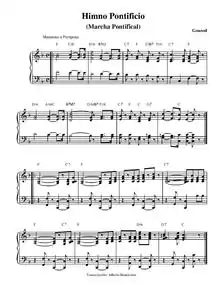Pontifical Anthem
The "Pontifical Anthem and March" (Italian: Inno e Marcia Pontificale), also known as the "Papal Anthem", is the anthem played to mark the presence of the Pope or one of his representatives, such as a nuncio, and on other solemn occasions.[1] When the Vatican's flag is ceremonially raised, only the first eight bars are played.[2]
 Sheet music for the "Papal Anthem" | |
National anthem of | |
| Also known as | "Marche Pontificale" (English: "Pontifical March") |
|---|---|
| Lyrics | Raffaello Lavagna, 1991 |
| Music | Charles Gounod, 1869 |
| Adopted | 1949 |
| Preceded by | "Marcia trionfale" |
| Audio sample | |
"Inno e Marcia Pontificale" (instrumental)
| |
 |
| This article is part of a series on |
| Vatican City |
|---|
While the Papal Anthem also serves as the national anthem of the Holy See and the Vatican City State, the Vatican stresses that it "is not to be understood as a national anthem"; it is a composition whose words and music "speak to the heart of many throughout the world who see in Rome the See of Peter."[1]
History
The music was composed in 1869 by Charles Gounod, for the celebration on April 11, 1869 of Pope Pius IX's golden jubilee of priestly ordination. The purely instrumental piece in three parts,[3] originally called "Marche pontificale" (French for "Pontifical March"), became extremely popular from its first performance.[1][2] It was first performed that day at four o'clock in the afternoon with seven pontifical bands and a chorus of over one thousand soldiers.
On October 16, 1949, Pope Pius XII declared it the papal anthem, replacing Viktorin Hallmayer's "Marcia trionfale" (1857), which, being still the papal anthem when the Vatican City State was founded in 1929, had been treated also as the new state's anthem. Gounod's "Marche Pontificale" was first performed in this new role during a ceremony on Christmas Eve of 1949, one day before the opening of the Holy Year 1950. The old state anthem too was played for a last time, almost as a token of respect.[1]
At that time, Antonio Allegra (1905–1969), who was then one of the organists of St. Peter's Basilica, wrote Italian lyrics[4] for Gounod's music. Other lyrics have been composed for the music in various languages and by different authors.[4] In 1991, Raffaello Lavagna of Savona (1918–2015) wrote Latin lyrics for a four-voice choir, on an arrangement by Alberico Vitalini.[3]
Italian lyrics by Allegra (1949)
- Original Italian[4]
- Roma immortale di Martiri e di Santi,
- Roma immortale accogli i nostri canti:
- Gloria nei cieli a Dio nostro Signore,
- Pace ai Fedeli, di Cristo nell'amore.
- A Te veniamo, Angelico Pastore,
- In Te vediamo il mite Redentore,
- Erede Santo di vera e santa Fede;
- Conforto e vanto a chi combatte e crede,
- Non prevarranno la forza ed il terrore,
- Ma regneranno la Verità, l'Amore.
- Salve Salve Roma, patria eterna di memorie
- Cantano le tue glorie, mille palme e mille altari
- Roma degli Apostoli, Madre guida dei redenti
- Roma luce delle genti, il mondo spera te!
- Salve Salve Roma la tue luce non tramonta
- Vince l'odio e l'onta lo splendor di tua beltà
- Roma degli Apostoli, madre guida dei redenti
- Roma luce delle genti, il mondo spera te!
- An English translation[4]
- O Rome immortal of Martyrs and Saints,
- O immortal Rome, accept our praises:
- Glory in the heavens to God our Lord,
- And peace to men who love Christ!
- To You we come, Angelic Pastor,
- In You we see the gentle Redeemer,
- The Holy Heir of true and holy Faith;
- Comfort and refuge of those who believe and fight.
- Force and terror will not prevail,
- But Truth and Love will reign.
Latin lyrics by Lavagna (1991)
|
|
References
- Pontifical Anthem and its History. From the official site of Vatican City State. Accessed on 2009-06-21.
- Pontifical Anthem and its History (in Italian). From the official site of the Holy See. Accessed on 2009-06-21.
- Score for choir of four voices by Alberico Vitalini with original Latin text by Monsignor Raffaello Lavagna. From the official site of the Holy See. Accessed on 2009-06-21.
- Inno Pontificio lyrics, with brief historical notes and MIDI file. From the official site of the Holy See. Accessed on 2009-06-21.
Further reading
- PDF, info here